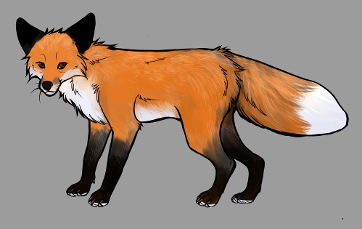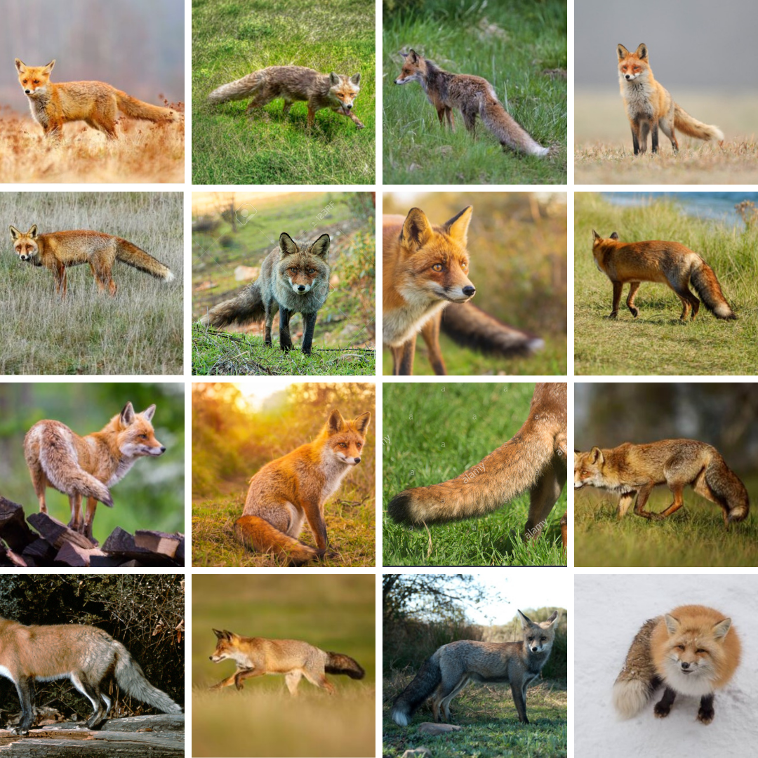
Silver Fox Colour Mutations
All the illustrations created in this colour guide are property of Alyssa N. Newsome, and at this time, are not to be redistributed, re-uploaded, copied, whole or in part, anywhere else.
The farmed North American red fox or "silver fox" has been a staple for the fur trade since the late 1800's. Through generations of selective breeding, the melanistic North American red fox now exists in over 70 different colour mutations. Below is a description of the genetics of the different colour morphs from this "fox rainbow" as confirmed by the book 'Beautiful Fur Animals and their Colour Genetics'.
For more on red fox colour mutations, please visit FAQ - UK Fox Colours, Living with Foxes, My Fox Family, Fox Paradox, and Wildlife Online.
Recessive Mutations of the Gold Fox
Albino & Leucistic Mutations
Silver Fox & Recessive Mutations
Brown Mutations
Grey Mutations (Pearl Types)
Brown & Grey Combination Mutations
Cross Foxes & Recessive Mutations
Fire Factor Mutations
White Series & Their Combinations
Platinum Mutations
Marble Mutations
Georgian Mutations
Extinct Mutations
Colour-Changing Foxes
Fox Tail Variation
INTRODUCTION
Naming of foxes can be confusing, as there are three different kinds of names - registered marketing names and names describing the genetic type of the fox, as well as aliases for a genetic type (for example, 'Autumn gold' for amber gold fox). Exact genetic names are generally not needed by the consumers of pelts and people buying a fox as a pet. Having a 'market name' for similar colours makes it much simpler to refer to the colourations, and is especially helpful when there is a fox or pelt that cannot be reasonably identified with a specific genetic type.
Market names can refer to several different genetic types. For example, in red foxes, the marketing name ‘pearl’ will encompass all types of pearl, ‘burgundy’ encompasses all types of dark brown mutants, and ‘arctic fire’ is the name of not only fire factor gold foxes but also fire factor silver, gold and pearl cross foxes. It is therefore not incorrect to call a pastel fox a burgundy fox, but it is not exactly accurate.
This can make it very confusing for those who don’t understand how these names work and end up inaccurately labeling a colour or naming it a colour that isn’t actually recognized. If the colour and genetics of a specific individual are uncertain, it is better to use a market name to encompass all possibilities of what it could be than use a specific and possibly inaccurate genetic name.
Similarly, wild foxes that are seen should generally not be assigned a very specific genetic name if the genotype is unknown, and can even be given a name based on standardized understanding of the colour systems in mammals. Another factor in wild foxes is the variation of colours across subspecies, which makes it complicated in a way that does not need be categorized as captive colours.
In this guide, the foxes will be named by their genetic name first, market names second, except in instances where there is a potentially wide variety of very similar colours (for example, Amber marble will refer to true Amber marble, as well as accounting for the possibility of other light brown mutant marbles like fawn glow marble). An example of European market names can be viewed here.
Scandinavian Gene Symbol System
AA - Red
BB - Silver
CC - Albino
GG - Burgundy
PP - Pearl
SS - Mansfield Pearl
RR - Radium
ww - White Series
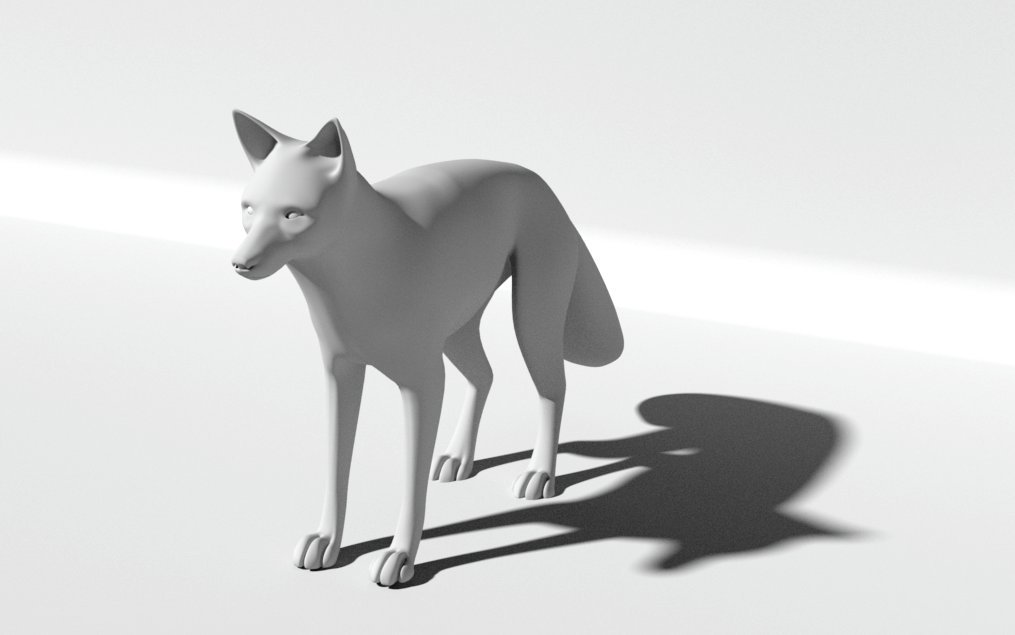
Download full Scandinavian Gene Symbol System here.
Coat Colour & Digestion in Foxes
A study was conducted into the effect of genes affecting hair colour on the antioxidant and digestive systems in foxes using four selected genotypes; Red, Platinum, Snow (Georgian White) and Pearl. It found that those mutations with a weakened form of pigmentation have peculiarities in the functioning of antioxidant and digestive systems.
"The influence of the genotype is manifested at the level of low molecular weight antioxidants [glutathione, vitamin A and vitamin E]... High proteolytic activity is observed in the pancreas of the Red... type foxes, the genotype of which is closest to the wild type. At the same time, the high amylase activity found in the snow mutation may be associated with the adaptation of the digestive system to the absorption of food with a greater proportion of carbohydrates.
Discriminant analysis of all the parameters studied showed significant differences between snow and pearl foxes. Thus, in foxes of the studied genotypes, the pleiotropic influence of genes affecting the color of fur, determines the peculiarities in the functioning of the antioxidant and digestive systems, which are more pronounced in color forms with weakening of pigmentation.
It is suggested that mutations affecting the coloring of the hair, affect the biogenesis and functioning of secretory organelles and thereby affect all processes of intracellular transport."
RED FOXES (AA BB) and RECESSIVE MUTANTS of the RED and GOLD FOX (AA Bb)
Red Fox
(Standard red fox) Red + Red - AABB
Red is the most common, typical colour of the red fox, alongside the gold fox, although they are not technically the same colour. While both gold foxes and red foxes are referred to as red foxes, the true ‘red fox’ is genetically distinct from the gold fox and does not have as much black on the body. Red foxes can vary in colouration across captive and wild subspecies, and even within subspecies the colour can vary from pale to deep red because of polygenes involved.
Subspecies living at higher altitudes tend to have paler coat colours, and some lineages lack the distinctive white tip of the tail, though most foxes born in captivity will have a white tip.
Gold Fox
(Smoky red, bastard fox, standard cross) red + silver - AA Bb
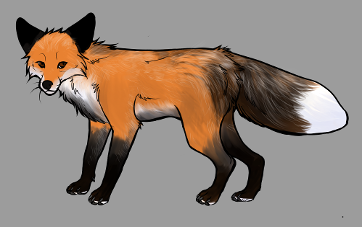
The gold fox, also known as the smoky red, but not to be mistaken for the true red fox. Less frequently this colour is called the “bastard fox” in reference to it being born of matings between true red foxes and silver foxes, and for the same reason is sometimes referred to as the standard cross fox.
The gold fox is darker in colouration than the red fox, with more dark guard hairs on the tail, and has a distinctive dark belly.
This is where the ‘smoky’ name comes from. "Gold fox" is used as a term for both colours in marketing and in this guide to accounts for red and gold foxes.
RECESSIVE MUTANTS of the GOLD FOX
Recessive mutants of the gold fox refers to colouration's that occur on a red (AA BB) or gold (AA Bb) fox background. Colours of the body that are normally black are replaced by a recessive silver colour mutation.
Burgundy Gold Fox
(Cinnamon gold) gold fox + burgundy - AA Bb gg
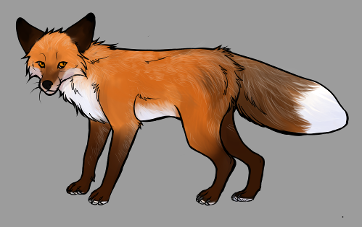
In this section, the burgundy gold fox refers to the colour as it occurs on the gold fox, replacing normally black areas of the body such as the ears, legs, and belly, with a dark red-brown colour.
This colouration is often referred to as a cinnamon gold as well. However, this colour shares its name with burgundy gold cross and burgundy silver cross foxes, where the burgundy colouration occurs on a silver or gold cross background.
This sort of colour, while being genetically distinct from a true burgundy fox, is often similar enough in appearance to pass as a pure burgundy fox. Hypothetically, other brown mutants could also create a colour that could be considered burgundy gold as well.
Pearl Gold Fox
(Dakota gold) pearl + gold fox - Bb pp
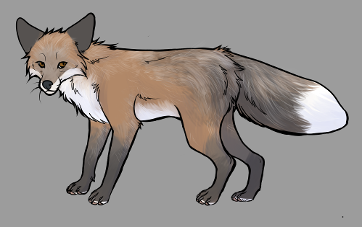
When pearl is added to a gold fox, normally black areas of the body are replaced with gray. The pearl factor dilutes the black areas, resulting in a fox legs and ears appearing to be a gray colour.
Amber Gold Fox
(Autumn gold, Dakota gold) amber + gold fox - Bb gg pp
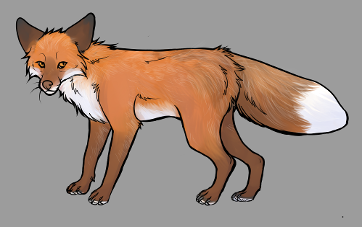
When amber is added to a gold fox or any type of cross fox, the result is the amber gold fox, where the black on the fox is replaced with amber.
This colour can also share the name “Dakota gold” with the red pearl and is sometimes marketed and sold as pearl gold because of the similarities in appearance. The colour of the amber gold generally is more of a brown-gray than the pearl gold.
Amber gold or silver cross foxes are also referred to as amber or autumn gold foxes.
ALBINO and LEUCISTIC MUTATIONS of VULPES VULPES (cc)
This following section will discuss unusual naturally occurring coat mutations.
Albino Fox
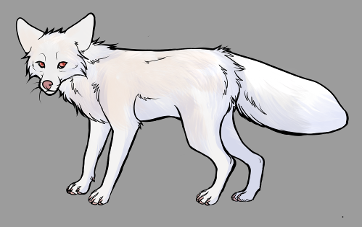
Albinism is the result of a lack of melanin, a dark pigment. Albino foxes occur naturally in the wild, but seldom survive to adulthood, like many other albino animals across other species.
The gene is recessive, and occurs in the albino locus. Like other albino animals, albino foxes are susceptible to complications, such as sensitivity to sunlight. Albino foxes often have blue eyes, but there are reports of red-eyed variants.
Leucistic Fox
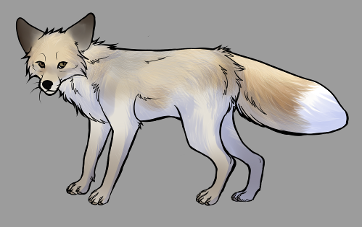
Leucistic foxes are the result of the partial or total lack of multiple colour pigments, compared to albinism which only effects melanin. Leucistic foxes also generally do not have blue or red eyes like albino foxes.
Leucism in foxes is not well documented in captivity, but they are a rare occurrence in the wild. The gene that causes this colouration tends to be isolated to certain areas.
In the US, multiple leucistic foxes have been documented in Massachusetts. Likewise, there are also populations in the UK. Leucistic foxes can vary from being totally white, nearly white with darker markings around their legs, face or back, or they can just have a very diluted appearance.
SILVER FOX and RECESSIVE MUTANTS of the SILVER FOX
Silver is a colouration present in both wild and captive populations, and is very common in the latter due to market demands. The fur quality of the silver fox described as silkier and longer than that of the red fox. The colouration was originally called black fox before the foxes were selectively bred for their silver hairs, a polygenetic change in appearance.
Silvers are difficult to tell apart, and to many pet breeders the type of silver is not important. However, knowing the underlying genetics at work are important for creating certain colours as some colours can only be produced with a certain type of silver. Breeding experiments can determine the type of silver of a fox. For example - if a fox is a true Alaskan silver (aa BB) if it is bred with a gold fox (AA Bb) , no silver foxes should be born, only gold cross and silver cross foxes (Aa BB or Aa Bb).
Silver foxes in captivity have selectively been bred for their black and silver fur, but silver foxes can appear almost brown and still have small amounts of brown. Wild born silvers can be brown in appearance, especially those living in thick forest ranges. The brown and grey colour mutants described in this section refer to colours expressed on a silver background.
Silver Fox
(Standard, sub-standard and double silver) AA bb - Aa bb - aa bb
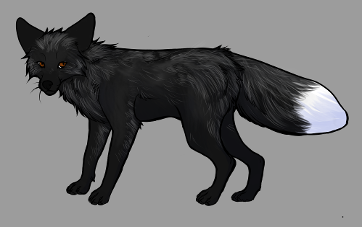
When it was curated in Canada, it was dubbed the ‘Eastern black’, but later the colour of the standard silver was selectively bred.
The standard silver is smaller than the Alaskan silver, with silkier, softer hair and clear black and silver colouration. This colour, and derivatives of this colour (substandard or double silver) are preferred by fur markets.
Offspring of the Alaskan silver and standard silver - same in appearance as the standard silver fox. Offspring of the sub-standard silver fox and standard silver fox. As clear in colour as the standard silver fox.
Alaskan Silver Fox
(Alaskan, sub-Alaskan) aa BB - aa Bb
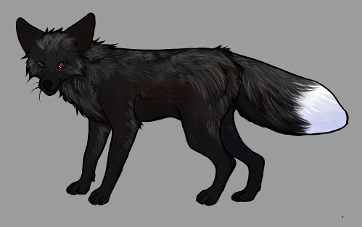
The ‘Alaskan black’ was the origin of this colour, and had coarser fur and less clear black and more brown in the fur until selective breeding made the differences in colour between this colour and the standard silver nearly indistinguishably.
However, Alaskan silvers today account for the silvers that have brown in their fur, particularly around the sides of the fox and around the ears.
This colouration is less common in fur markets, particularly Scandinavian markets, as a clear black colour is preferred over a coat with brown tinting. Offspring of the Alaskan silver and double silver - resembles the Alaskan silver more in appearance and coat quality.
Black Fox
(Appears within any silver fox lineage)
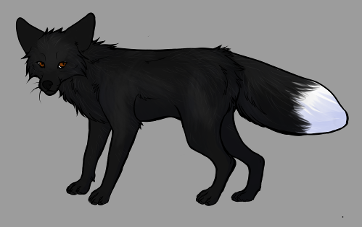
The amount of silver hair on the pelts depends not on the genotypes, but on quantitative inheritance, or simply speaking, the ‘strength’ of the genes involved.
There are six categories based on the amount of silver in the coat, on a spectrum from dark (black fox), 1/4, 1/2, 5/6, 1/1 silver. Because the fur markets favor paler silver foxes, black and near black foxes are rare.
BROWN MUTATIONS of the SILVER FOX
Brown mutants are colouration's in which the black fur of the silver fox is replaced with a brown colour. Burgundy is often used as a catch-all name for brown mutants, as well as a specific genetic name for true-burgundy foxes.
Colicott Brown Fox
(Colicott) (—) or brCbrC*
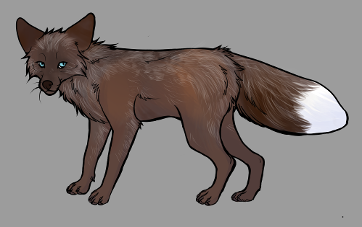
Colicott brown is not to be mistaken for burgundy or cinnamon. However, colicott brown lacks a gene symbol in the Scandinavian system as the relationship between colicott brown and other brown mutants is not clear.
However, the American system distinguishes the colicott brown as brCbrC. True collicott brown foxes will have blue eyes, as opposed to the brown, yellow or gold eyes of a burgundy fox.
Colicott brown and mutations associated with it are responsible for producing the fire factor seen in red foxes. *Colicott brown does not have a gene assignment within the Scandinavian system. This gene assignment is from an American-based, standardized colour systems for mammals.
Burgundy Fox
(Cinnamon, Fromm brown, chocolate) Silver + burgundy - gg
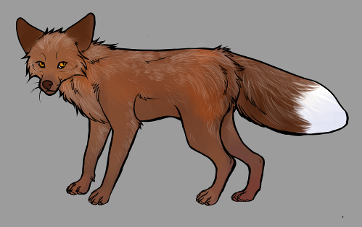
In comparison to colicott brown, true burgundy foxes have a more reddish-brown appearance. This colour is also known as cinnamon, or Fromm brown, named after the Fromm brothers where the colour was first documented.
Cinnamon is also generally used for redder burgundy foxes. It is a more common colour than colicott brown, accounting for most of the brown foxes seen in the pet trade, particularly in the US.
Burgundy can be combined with gold foxes or cross foxes carrying the burgundy gene to create burgundy gold foxes.
Bollert's Brown Fox
(Genetic background unknown)
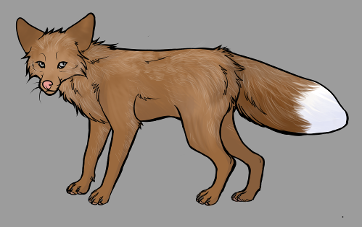
Bollert’s brown is a brown mutant out of Bollert’s farm in Canada, described as being a deep golden-brown, with pink noses and pale eyes. The colour is uncommon, and it’s relationship to other brown mutants is not understood.
This colour, however, is sought after to create dawn glow as it is the only colour that can produce it. Because of the rarity of the colour, it is not seen in the pet trade at this time.
Pastel Fox
(Polish pastel, Swedish pastel, Norwegian pastel. Lavender, Chocolate)
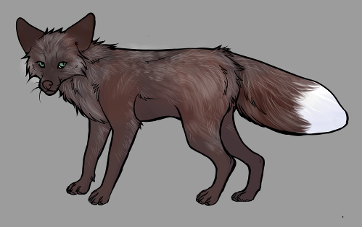
Pastel foxes includes the Polish, Swedish or Norweigian pastel. The pastel name comes from its resemblance to the pastel colour type of mink and nutria. Early pastels had notably poor temperaments, but continued breeding created a stable, healthy population comparable to the typical silver fox’s. Pastel foxes range in colouration from pale beige to dark brown and there is a wide variation in the silvering present.
The underfur of the fox can be pale beige, blue brown, or dark brown. Paler pastel foxes, with a fair amount of silver hairs and a smoky undercoat are sometimes referred to as Lavender foxes. Darker pastel foxes have brown eyes, but the colour of the eyes can be yellow, green, or in paler pastels, blue. However, most pastels are not blue eyed, and the presence of blue eyes are a rough indicator of whether or not the fox in question is pastel or colicott brown. Experimental breeding with colicott foxes revealed that they are not allelic; not genetically the same despite looking very similar.
Swedish pastel foxes are described as chocolate coloured. Norwegian pastel was a once common colouration that went largely extinct in the 1950’s, but the gene was carried in silver fox populations and reappeared later on. The Norwegian pastel is dark brown with brown eyes. Neither the Polish or Norwegian pastel appears to be as wide spread as the Polish pastel, nor are the exact relationships between the different pastel types fully understood.
Pastel fox genetics (along with the Georgian fox) are considered a protected agricultural resource in Poland today, in order to prevent loss of diversity and extinction. Part of a larger World Strategy for the Conservation of Genetic Resources of Farm Animals, developed by the United Nations Food and Agriculture Organization (FAO).
Programs for the Conservation of Genetic Resources of Farm Animals;
"The pastel fox is a native variation of the common fox. This mutation occurred in the mid-70's of the last century on one of the Wielkopolska farms... The common fox is found in three types: dark, medium and light. Color of the cover from dark brown to light brown. In the same color is the face, feet, ears and stomach. Brown hair cover strongly contrasts with unpigmented hair. The color of the undercoat is brown with a blue shade. The silver plating starts from the base of the tail and occurs up to half the length of the animal... The pastel coat is genetically determined by the homozygous system of two recessive bb genes. Heterozygotes - carriers of this gene [Bb] have the genotype of a silver fox and do not differ from homozygotes [BB]. Pastel colored genes do not belong to the same locus as genes conditioning the well-known varieties of common fox - platinum, white-skinned, whiteish. This can be evidenced by obtaining platinum pastels (with a platinum drawing on a pastel background)."
GREY MUTANTS of the SILVER FOX (Pearl types)
Grey mutants are also called the pearl types, as this category of mutants consists only of pearls. They’re also informally referred to as blue foxes, and wild colouration's are often generically referring to as blue foxes because the exact genotype cannot be determined. In captivity, there’s two genetically distinct pearl foxes, pearl foxes (pearl 1) and Mansfield pearl foxes (pearl 2).
Pearl Fox (Pearl 1)
(Pearl, eastern pearl, western pearl, cherry pearl) silver + pearl - pp
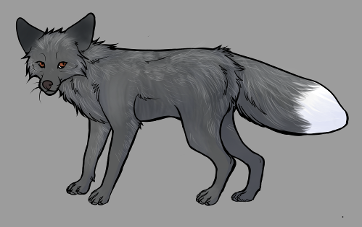
Pearl appeared in the 1920’s in the USA, but deviating colours were not tolerated on silver fox farms and individuals displaying the colour were pelted. Carriers survived and reappeared when the carriers were sold and exported to farms across North America and Europe. Most pearl types that showed up later at the same time were speculated descendants of the original pearl foxes through the silver carriers.
When the pearl colour appeared, again appeared across several farms and occurred at the same time, resulting in many different names for the same pearl type. The colouration also may have simply appeared in separate silver populations. Eastern and western pearl are genetically the same and Eastern is generally the name used to refer to the first pearl type.
Mansfield Pearl Fox (Pearl 2)
(Omberg pearl, Pavek’s pearl*) Silver + Mansfield pearl - ss
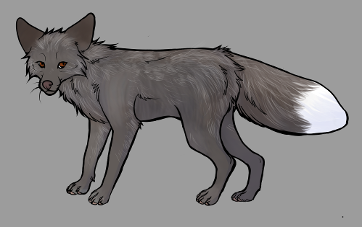
Mansfield pearl was named after the Canadian farm where it first was documented. In comparison to the pearl, the Mansfield may have a brownish tint, that was once more distinctive in the colouration but was improved with selective breeding for a more clear grey colour. An important characteristic of this type it it’s bleeding tendencies, caused by a disease known as Chediak-Higashi syndrome (CHS).
This interferes with the coagulation of the blood and results in longer bleeding times. The Omberg pearl is a colour sold and considered the same as a Mansfield, despite being more similar in appearance to the regular pearl type, but has the same bleeding tendency of Mansfield, in addition to having a weak immune system. Pigment in the hairs of the Mansfield and Omberg pearl is also clumped as opposed to evenly distributed. Both phenomenons are also symptoms of CHS.
Mentioned in literature is the Pavek’s pearl, only in reference to the Pavek’s sapphire, which was a cross of a Pavek’s pearl and eastern pearl. Pavek’s sapphire, despite not having a Mansfield parent, still had bleeding tendencies, so it’ could be assumed that Pavek’s pearl was another variation of the Mansfield type if it passed the bleeding tendency to its offspring.
It is recommended that if one wishes to produce a Mansfield pearl, that the father is a Mansfield and the mother is a silver carrier of the gene, as a Mansfield mother risks anemia and death from bleeding out during birth, losing the litter, or weak, slow developing pups, partially due to poor milk production of the mother. This colouration, alongside sapphire foxes, are quite rare and near non-existent in the pet fox trade.
*Pavek's pearl not confirmed to be alleic with Mansfield and Omburg.
"Pearl foxes or Blue foxes (as the different pearl phenotypes are collectively known) are a grey mutation of the silver fox. They were first reported in Minnesota as early as 1924 (La Due), with two different mutations being reported in 1942 (Deakin). There are three genetically distinct Pearl lines known today, the Eastern Pearl, the Western Pearl and the Mansfield Pearl. Pearl foxes have a grey colouration that ranges from light to dark grey, similar to that of Silver foxes, however, they carry a recessive trait that when 2 copies are present, "dilutes" the coat colour, giving it a lighter, blue-ish hue (the Pearl gene is a dilution gene). Their eyes are most commonly yellow or green and their noses are grey rather than black (sometimes with a red hue). Pearl pups have significantly thicker dermal tissue than fox cubs of other colour morphs, and foxes from the Mansfield Pearl line have slower coagulation rates than other foxes."
The Microstructure of the Skin of the Skins of Puppies of Foxes of Different Breeds;
"The paper presents new data on skin microstructure of daily and seven-month old fox pups of the following breeds: collicott, pearl and burgundy as compared to that of silver-black fox. It is shown that the pearl pups at one day and at 7 months of age have a significantly thicker dermal tissue, the thickness of the epidermis and dermis. By 7 months the epidermal thickness decreases by 15.5-20.0%, and the thickness of the dermis increases in all fox breeds."
BROWN and GREY COMBINATION MUTANTS of the SILVER FOX
Recessive combination types are the result of combining grey and brown mutants together. These combination types, like the brown and grey mutants, occur on a silver background, and the type of silver used can have an impact on the colour variation’s appearance. These combination types often come out as a result of multiple generations of work in isolating the colour. The term amber can also refers to all light brown colour combination types, including fawn glow, true amber, snow dawn, etc.
Amber Fox
(“Golden Glory”, snow dawn) Burgundy + pearl - gg pp
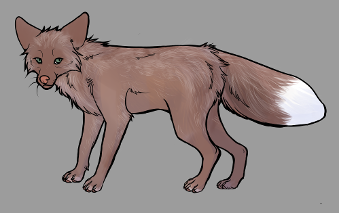
It is believed that the Amber was first developed by the Fromm brothers and named the ‘golden glory’, but the name amber was established as the marketing name. Amber is the result of burgundy and pearl genes combined.
There is wide variation in the colour of the amber due to underlying genetics, and the type of silver fox that is used to produce the colour.
Ambers can range from a muted gray-brown colour to a bright, pale brown that can be mistaken for a pink fox. There is wide variation in the colour of the amber due to underlying genetics, and the type of silver fox that is used to produce the colour. Amber's can range from a muted gray-brown colour to a bright, pale brown that can be mistaken for a pink fox. Amber foxes can have distinctive green eyes as well. However, it is said that the main indicator between an amber fox and a fire factor fox such as a colicott or a fawn glow fox is the presence of blue eyes, as amber foxes will not have blue eyes. Breeding tests can confirm or refute the fire gene in an individual. Snow dawn is a colour mentioned in literature as being a colour similar to amber, possibly even just a bluer shade of it. Snow dawn is also used as a name for amber and fawn glow foxes.
Pink Champagne Fox
(Champagne, Pink champagne) Collicott brown suspected to be involved
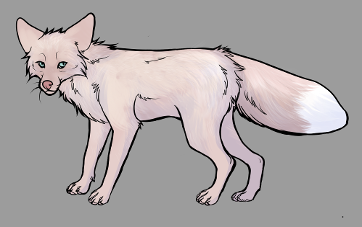
This is a colour present in Canada, the US and in Scandinavian countries, where it is believed to have originated and just recently entered the pet trade in the past few years. It is, however, not considered valuable by the fur markets, perhaps because similar colours can be produced more easily and consistently and therefore it is easier to colour match fur products. The fire factor present in the pink fox can also cause the unwanted dilution of colours desired by a fur farmer.
The colour of the pink fox varies from a darker, dirty beige that can be mistaken for amber, to a pale, nearly white colour. Pink foxes often have blue eyes and pink noses. The exact genetics behind this colour is largely unknown, but it’s believed to be derived from colicott brown and colours carrying the colicott gene such as fawn glow. This is reaffirmed by fire factor kits being born out of litters with champagne parents, indicating that the pink fox carries the fire gene, as well as fawn glow foxes being born out of litters of champagne parents or parents carrying the champagne gene.
This colour is often confused as being albino or leuistic but it is not likely to be related to either. Should the pink fox be related to the fire gene as it is speculated, the fire gene is suspected to operate within the D locus or the dilution system, which dilutes colour pigments. Should this be true, it is a separate effect of that of albinism and leucism which operates in the C locus or in the albinism system that controls whether or not certain pigments are expressed at all. This colour is also frequently mistaken for a true amber fox, but amber foxes are a combination of burgundy and pearl, whereas pink foxes are not born from this combination.
Palomino Frost Foxes
"Palomino Frost Fox, also known as Apricot Fox, is still a rather uncommon mutation fox created by combining the genes of a Palomino/Champagne Fox with a Polar Pearl fox. The result is a striking, extremely pale cream-colored fox with peachy, golden tones on its back."
"All Palomino Silver Foxes in the whole world originate from one particular fur farm in Ostrobothnia, Finland. This hasn’t been an easy route, it has altogether taken over 10 years of careful selective breeding. It all started in 2005, when a Finnish fur farmer imported Pastel Foxes from Poland to Finland... After many years of selective breeding, the first ever Palomino type was born in 2013. The farmer had finally figured out the genetic combination, but he was not satisfied with the quality. So during 2016, 2017 and 2018.. he left them to a good friend, who helped him mate his foxes with their Norwegian 'Choco Silver Foxes' of outstanding quality... it was a success."
Fawn Glow Fox
(Fawn glow) Collicott brown + Pearl 1 (Eastern pearl)
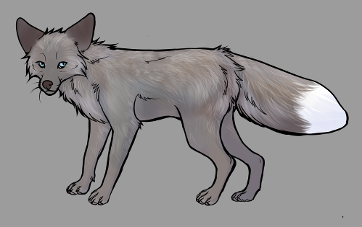
Fawn glow is created by the combination of the factors colicott brown and pearl. The colour is similar to amber, but is more of a blue colour, brown tinting, resembling a muddy sapphire, but the colour can vary to look almost indistinguishable from amber. The colour, as well as varying in brown or gray, can vary in darkness to a deep, rich colour a pale, light, smoky one. A defining feature of the fawn glow is the blue eyes, as blue eyes are not present in amber foxes.
Fawn glow also is responsible for the fire factor, and therefore has a completely different effect on gold and cross foxes than amber does. Fawn glows seem to appear in litters from pink fox parents or with pink fox lineages, which could be further evidence for the connection of pink to the colicott gene.
Dawn Glow Fox
(Dawn glow) Bollert’s brown + pearl - ??
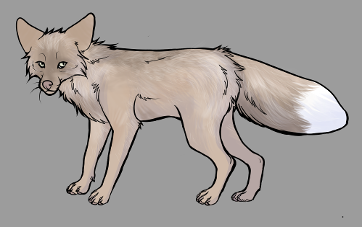
When Bollert’s brown is applied to pearl, it creates the dawn glow, not to be confused with fawn glow or the snow dawn.
This colour can only be produced with Bollert’s brown. Dawn glows are a pale gray-brown, with a darker coloured cross. The silver guard hairs over the pale undercoat make for a very radiant appearance.
It has been rumored that Bollert's brown and dawn glows are connected to pink foxes, but this does not appear to be the case.
Sapphire Fox
(Pavek’s pearl) Pearl + Mansfield pearl - pp ss
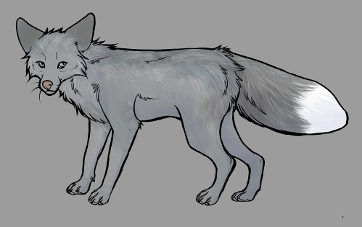
When the two types of pearls are combined, sometimes a very bright, clear blue fox is produced, called a sapphire. Though the amount of silver can vary, large amounts of silver guard hairs over the blue coat creates a very brilliant, bright appearance. It is speculated that if more than two genetically distinct pearl types exist, other blue combinations similar to sapphire could be produced. Because the Mansfield pearl factor is involved in this colouration, these foxes
unfortunately have CHS and the associated bleeding tendency. For this reason, the two pearl parents should be a eastern pearl mother, and a Mansfield pearl father, and female sapphires should not be bred. As mentioned before, this colour has also possibly been referred to as Pavek’s sapphire when a Pavek pearl parent replaces a true Mansfield, but they aren’t notably different genotypically or phenotypically. Sapphire foxes are quite difficult to breed even within the fur trade, and are practically non-existent within the pet trade.
Pearl Amber Fox
(Sapphire amber) Burgundy + pearl + Mansfield pearl - gg pp ss
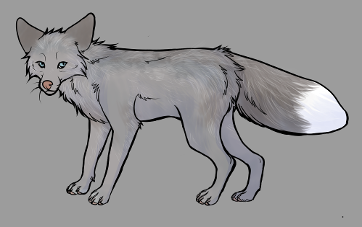
When amber is used instead of eastern pearl and combined with a Mansfield pearl, the pearl amber, also known as a sapphire amber in North America, is created. The colour comes as a result of the burgundy factor being added to the two different pearl types. The pearl amber strongly resembles a sapphire, but instead of a clear blue, the fox has a brown tint, resulting in a lavender appearance.
This fox is very similar in appearance to the fawn glow, but is distinct in that it does not have the fire factor gene. It is in fact a rarer colouration, because it requires both pearl types.
CROSS FOXES and RECESSIVE MUTATIONS of CROSS FOX
Cross foxes are created when red and silver foxes are crossed, and are named for the dark cross across the back, neck and shoulders of the fox. The amount of red or silver present on the fox depends on the type of parents and polygenes involved. When recessive mutants are applied to either a gold or silver cross fox background, it replaces the black of the silver expressed on the fox with the colour factor responsible, and the red colouration is left largely intact. In theory, any recessive mutants of the silver fox like the brown, grey, or combination mutants can be included in a cross.
Cross Fox
(Golden cross fox, Alaskan cross fox) Alaskan silver + red fox- Aa BB
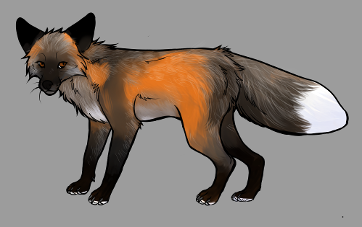
The gold cross fox is created with Alaskan silver and red parents, as crossing a silver fox with a red fox will result in a gold fox instead of a cross fox.
Silver Cross Fox
(Blended cross fox) Alaskan silver + standard silver Aa Bb
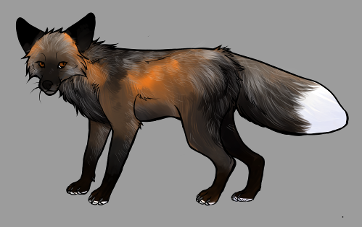
The silver cross fox, also known as the blended cross, can typically be obtained by crossing an Alaskan silver with a standard silver, or any other combination of parentage that will cause the silver and red gene to both be in heterozygous condition. The silver cross is darker than the gold cross, with more black and silver covering the body, and some particularly dark individuals can visibly pass as a pure silver.
Mating two silver crosses together, because of the alleles involved, can in theory create every type of red, silver, silver cross and gold cross foxes, demonstrated by this chart.
Pearl Cross Fox
(Pearl cross) Pearl cross fox + pearl -Aa BB/Bb pp
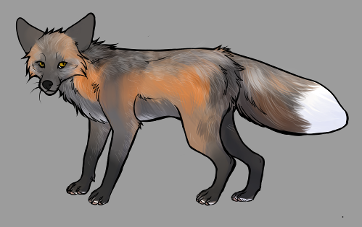
When the pearl factor is added to a cross fox, the black is replaced with the gray of the pearl factor. The amount of pearl on the body depends on the type of cross - a silver background will have a greater amount of pearl than a pearl gold cross. Sapphire crosses may also exist, in which case the genotype would be presumably Aa BB pp ss or Aa Bb pp ss, and shouldn’t be mistaken for the sapphire cross arctic-red fox hybrid of the same name
Burgundy Cross Fox
(Cinnamon gold, burgundy gold) Silver/gold cross + burgundy - Aa BB/Bb gg
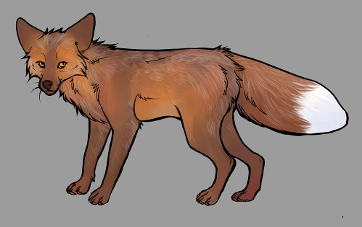
In burgundy cross foxes, normally black areas are replaced with a dark red-brown colour, and is most noticeable on a gold cross fox. When the burgundy occurs on a dark silver cross, it is difficult to tell that it is a cross fox at all because of the similarity between the recessive burgundy colour and the natural red colour of the fox.
The burgundy cross fox share it’s name burgundy gold with true burgundy gold foxes.
Burgundy cross” can also serve as an umbrella term for any dark brown cross mutant.
Amber Cross Fox
(Amber gold fox) Silver/gold cross fox + amber-Aa BB/Bb gg pp
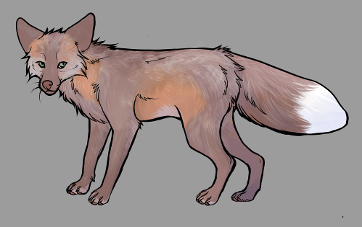
Descriptions of amber cross foxes describe amber gold cross foxes as having much less prominent red colouring, and amber silver crosses as closely resembling true amber foxes.
Amber cross foxes could possibly account for "beige" cross foxes, alongside other pale brown crosses with unknown genetic backgrounds.
Pink Cross Fox
(Pink champagne cross fox, champagne cross fox) Pink fox + pink fox - ??
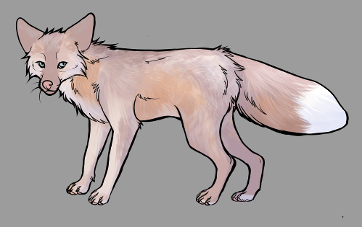
In the typical appearance of a cross fox, there is a dark pink cross on the body on top of diluted red.
In the pink cross, the red appears to be somewhat diluted by the pink, likely due to the suspected involvement of the fire factor gene.
Very pale individuals can closely resemble a darker pink (pelt). Pink crosses are often reportedly born in litters from two pink parents.
It’s unclear why the pink would replace the black on the body, as this is not the behavior of a fire factor fox's gene (such as the pink is suspected to be; fire factor does not impact the black pigment in gold, red, and cross foxes), so it is clear that more genetic investigation needs to be done.
FIRE FACTOR MUTATIONS of the SILVER FOX
The fire type or fire factor foxes originated from US farms, though the exact farm where the gene first appeared is unknown. This colour became coveted in the mid-1970’s and became popular. For this colour to appear on a fox, it must be expressed on a gold or cross fox background, as the gene responsible for diluting colour only affects red or yellow melanin, pheomelanin, but has no effect on the black colouration of a fox. In order for the black to be diluted, another colour factor must be responsible, such as pearl diluting the black and fire diluting the red, in this example resulting in a fire and ice fox.
Fawn glow, pink and collicott brown appear to cause the fire factor to appear, so it is assumed that the colicott factor (present in the fawn glow) is equal to the fire factor gene, and therefore it is further speculated that colicott brown is not a single recessive gene in of itself, but rather a a result of the interaction between the fire factor applied to a certain type of silver. The exact behavior of this gene still is not fully understood. For the two fire gold types, wildfire and golden sunrise, to be produced, there must be no other recessive genes present. How pale the fox is depends on how intense the original red colouration was before the dilution of the fire factor was added.
Wildfire Fox
(Fire gold fox) Red fox + fire factor - AA BB + fire factor gene
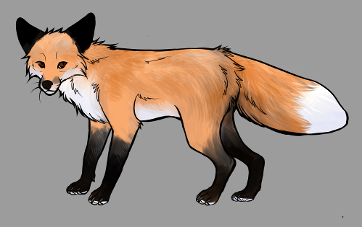
A true wildfire fox is a red fox with the fire factor added, which means the genes involved must be in homozygous condition (AA BB + the fire factor).
Golden Sunrise Fox
(Fire gold fox) Gold fox + Fire factor - AA Bb + fire factor gene
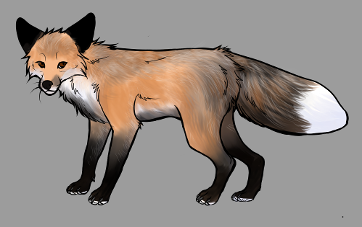
Likewise, a true Golden Sunrise will be the fire factor expressed on a true goldfox background, where the silver gene is in heterozygous condition.
Fire Cross Fox
(Fire cross) Gold cross or Silver cross + fire factor - Aa BB/Bb + fire factor gene
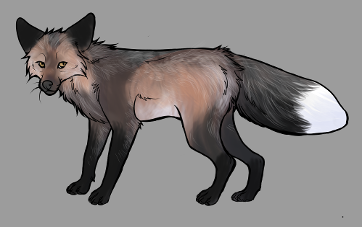
The fire cross fox is the fire factor applied to either the gold cross or the silver cross. It can be difficult to tell that a fire cross fox exhibits the fire factor gene at all, especially in dark silver crosses where there is little red present originally and the areas that were red become cream, which resembles swatches of silver rather than diluted red.
However, comparing a fire silver cross to a silver cross, especially at a young age, can make it
obvious that the fire factor is present. Fire cross foxes with the fire factor in homozygous condition are also sold as snow glows alongside homogyzous fire factor gold foxes.
Snow Glow Fox
(Snow glow) Homozygous fire factor + gold/cross fox background + pearl, colicott, or colicott + pearl / fawn glow - AA BB/Bb + fire factor + pp or pp/gg
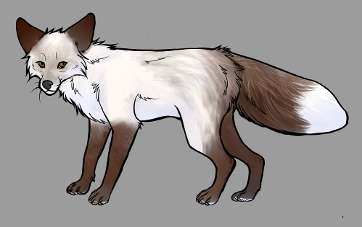
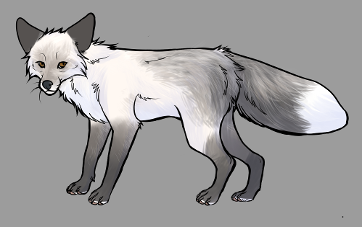
Snow glow can refer to any pearl, colicott or fawn glow on a gold or cross fox with the fire factor applied in homozygous condition, which compounds the effect of the fire factor, making normally red areas of the body very washed out and off-white. Whether the legs and other areas of the body are gray or brown depends on the type of parents used to produce the colour. The colours below depict a gold fox background, but snow glow can refer to the heterozygous fire factor on a cross fox background where pearl, colicott or fawn glow (colicott + pearl + burgundy) is involved.
The most direct way to produce this colour is to breed a fire and ice fox to a colicott or fawn glow fox. Depending on the parentage, the results may be snow glow gray or snow glow brown. The eyes of these foxes can also range from gold, brown to green and blue - blue being an indicator of the fire factor.
Fire and Ice Fox
("pale" fire and ice, Arctic fire, moon glow/glo) Pearl gold + fire factor - Aa BB/Bb pp + fire gene
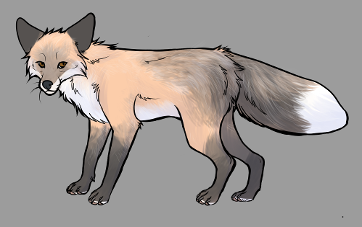
Also known as an arctic fire, a fire and ice fox is the result of a gold or red fire factor fox (a golden sunrise or a wildfire fox) with the recessive pearl factor added. When this particular colour shares a name with a moon glow in the context of both of them being considered fire and ice, the fire factor gold pearl fox (pictured to the right) is called the “pale” fire and ice, while the fire factor pearl cross fox is referred to as the “dark” fire and ice (also known as “Moon glow”, pictured below.)
Moon Glow Fox
("Dark" fire and ice, arctic fire, moon glo) Pearl cross fox + Fire factor - Aa BB/Bb pp + fire gene
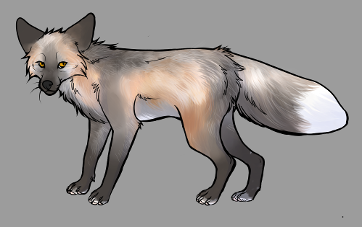
“Moon glow” is the result of a pearl cross fox with the added fire factor. Moon glow shares the market name “arctic fire” with the fire factor red pearl fox, and is considered a “dark” fire and ice.
The cross background may be either gold or silver; gold cross backgrounds will result in paler individuals as there is more red to be diluted
Autumn Fire Fox
(Amber gold fire) Amber gold + fire factor- pp gg + fire gene
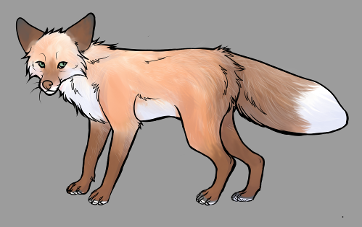
When the fire factor is applied to an amber/autumn gold fox, it creates a fairly uncommon colouration known as “autumn fire”. Pale variants of this colour can closely resemble brown snow glow foxes, but they are not true snow glow foxes as snow glow must have the fire factor in heterozygous condition.
The red on the fox is diluted by the fire factor, while the legs, tail, ears, and face are amber.
WHITE SERIES and WHITE SERIES COMBINATIONS in the SILVER FOX
The white series of the red fox refers to all colouration's that occur in the WW (white locus) colour factor of the red fox in the Scandinavian system of colour gene categorization. ww is the recessive, dormant form of the gene. Most of the white series mutations are either partially or completely lethal in heterozygous form, resulting in reduced litter sizes due to embryonic death, or kits born sickly that rarely reach adolescence. This effect is similar to “lethal white syndrome” in white horses and dogs, particularly in certain breeds such as Australian shepherds.
In this colour guide, any colour name with the ‼ symbol next to it denotes that the gene is lethal in heterozygous form, and the colour should not be bred to another fox of the same colour, or of another colour that is also lethal in that form. For example, white marks, platinum and Georgian white foxes all should not be bred to one another. This holds true for any of these colouration's regardless of the base colour; e.g. a gold platinum is not safe to breed to a pearl white mark.
As the gene is dominant, the most direct way to reproduce the colour is to simply breed a fox displaying the colour with a fox that lacks the gene. For example, breeding a white mark to a silver will result in a 1:1 litter proportion of silvers and white marks.
White Mark Gene Symbol System:
W - White Face/Whitemark (Hovebrender platinum)
Wp - Platinum (Mons platinum)
WMw- Marble (Arctic marble)
WGw - Georgian White (Snow mutant)
WMWM - White Marble (White arctic marble)
WpWM - Marble Platinum
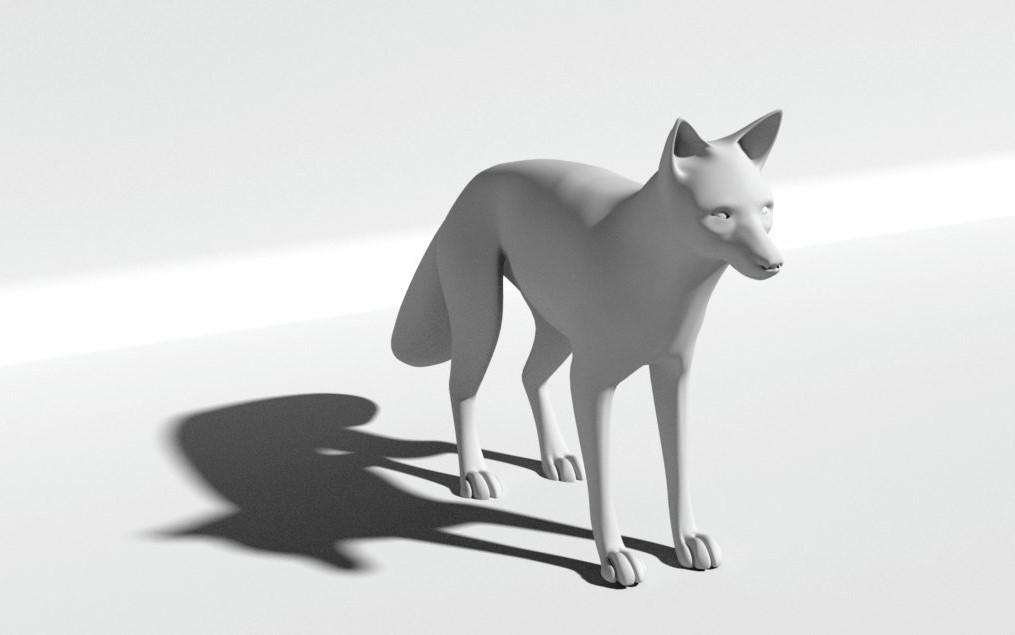
Download full Scandinavian Gene Symbol System here.
The Inheritance of the Platinum and White Face Characters in the Fox;
"Several new colour phases have appeared among farm bred silver foxes, and three such mutants are well described in the literature... the white face, platinum and pearl platinum fox... The platinum fox is in the U.S. usually called "platinum silver" or "Norwegian platinum", in Canada "standard platinum", and in the Scandinavian countries "Mons-platinum" - after the original mutant - or simply platinum. The latter term would seem to be adequate. Different names are also used for the white face fox, e.g. ,"white-marked silvers", "ring-neck" or "platinum type silver", while in Norway it is spoken of as "Hovbrender platinum". Any name of the white face fox, which involves the term "platinum"should, however, be avoided...
The white face fox is wry similar to the common silver fox, except that it has more or less extensive white markings on the nose, forehead, neck, feet, breast and belly; the tip of the tail is white to the same extent as in the silver fox. The pigmentation of the underfur, the guard hairs and the ears, trunk and tail has about the same intensity as in the silver fox, There is no sharp borderline between the silver and the white face fox; the former may have while markings on the feet, breast and belly, and the latter may lack the white blaze along the nose, and the white collar... The light white face fox often shows a kind of roaning, owing to the presence of numerous wholly white guard hairs among the banded silver hairs. These white hairs give to the fur a "dead" appearance, and the lustre of the fur will not be the same as in the true silver fox...
The white face mutation seems to have occurred independently at number of times in U. S. A., Canada and Scandinavia. COLE and SHACKELFORD speak of the Colpitts, McNeil, Garvey, Holman and Springborn strains of white face, some of which have probably descended from separate mutation's. The Colpitts strain seems to be the oldest one; it is said to have originated in 1928. The Hovbrender platinum (MOHR and TUFF, 1939) is nothing else but a white face fox which has originated in Norway... The white face foxes on Swedish fox farms derive From Canada, perhaps mostly from the McNeil strain, and from Norway. The writer does not know of any original mutations in Sweden, and all our white face foxes would seem to be identical as far as the genotype for this particular character is concerned."
WHITE MARK MUTATIONS of the SILVER FOX (Ww)
(White mark, White face, Hovbrender platinum, ringneck)
The amount of white present on the body of the fox as well as the variation of how dark the underlying colour is can cause this colour to be mistaken for platinum, and individuals with only “minute markings” can resemble a fox without the white mark gene present at all. In comparison to a platinum, generally speaking, white mark foxes have smaller areas of the body that are white than platinum, and whitemark generally preserves the under lying colour of the fox rather than diluting it (as opposed to platinum, which does). Whitemark is also known as “white face” or “Hovbrender platinum”. It is unclear if ringneck foxes are the same as whitemark, but it’s inheritance behaves the same as whitemark and platinum. Ringneck is distinguished from whitemark as having a white collar and a larger white tail tip like platinum, but the colour on which it occurs remains relatively untouched whereas platinum dilutes the colour. For the purpose of this colour guide, ringneck is considered a variation of whitemark.
Heterochromia can occur in this colouration, resulting in odd coloured eyes, such as one eye being blue and the other being brown, or the iris being partially brown or blue. These foxes can also have blue eyes. In addition, the noses of white mark foxes can be partially or completely diluted, becoming a paler colour or even pink either partially or wholly.
Silver White Mark Fox !!
(White mark, whiteface, Hovbrender platinum) Silver + white mark -BB/Bb/bb Ww
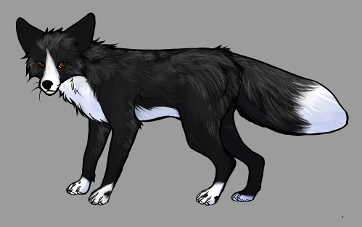
Also just called a white mark, a silver white mark is the white mark or whiteface colouration as it occurs on a silver fox.
Cross White Mark Fox !!
(Calico fox) Silver/gold cross + white mark - Aa Bb/BB Ww
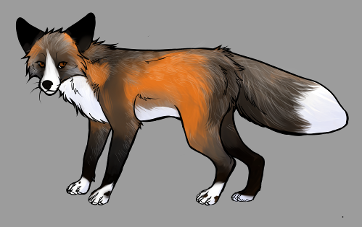
Whitemark colouration on a gold or cross fox background. This colour is also known as calico, which is also a shared name with cross platinum foxes.
Pear Cross White Mark Fox !!
(Calico, pearl calico, cross pearlatina. pearlatina) Silver/gold cross + pearl + whitemark - Aa Bb/BB pp/ss Ww
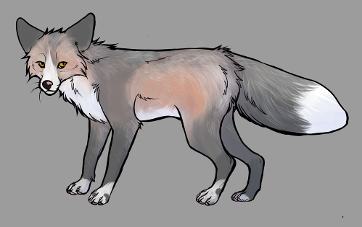
When a pearl cross has the white mark colouration occur on top of it, this is the colour that results.
This colour is also sometimes sold under the label of a calico fox despite not being a true gold or silver cross fox as the pearl gene is being expressed. It is also called pearlatina alongside pearl whitemarks themselves
Red White Mark Fox !!
(Calico) Gold/red fox + white mark -AA BB/Bb Ww
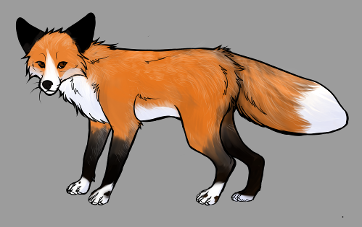
This is a mutation that has been allegedly documented in wild red foxes, particularly in Scandinavian where the colour is called ‘collar fox’ or ‘white marked red’. Simply put, is a red fox with the added white mark factor.
This colour is sometimes referred to as a calico, though that moniker is much more common for cross whitemarks and cross platinums.
Amber Pearl White Mark Fox !!
Amber (burgundy + pearl) + white mark - bb gg pp Ww
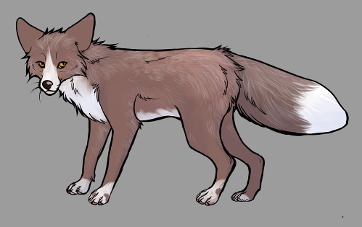
White mark added to an amber fox creates an amber white mark. To produce this colour, the parents would have to be a silver white mark carrying the amber gene bred to an amber fox or another silver fox carrying the amber gene.
Amber white mark is also a name for other pale brown mutants with white mark applied, e.g. fawn glow white mark.
Pearl White Mark Fox !!
(Pearlatina, Glacier, Glacier blue) Pearl + white mark - pp/ss Ww
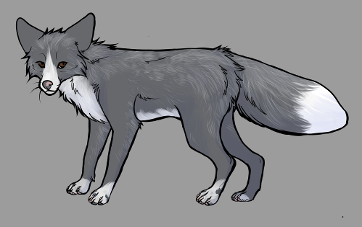
Though the name Pearlatina is not typically used in the contemporary fur market anymore, Pearlatina is the name for the pearl white mark fox.
More often, it is sold alongside pearl platinum foxes as ‘glacier blue’ or ‘glacier’ foxes despite not being platinum foxes, but rather carry and express the white mark gene. They therefore share the name glacier and glacierblue with pearl platinum foxes.
Fire and Ice White Mark Fox !!
Fire & ice + whitemark (gold/red fox + pearl + whitemark + fire gene) - AA BB/Bb pp Ww + fire gene
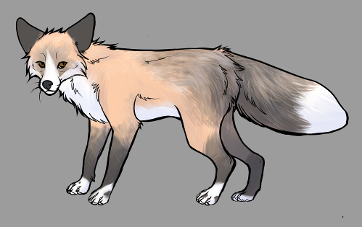
Fire and ice (in this section a fire factor pearl gold fox) applied to whitemark creates an interesting and unusual combination that is seldom seen.
This is only one example of the fire genes that can be combined with whitemark to create unique colours; other examples could include fire factor white mark cross foxes, fawn glow white mark, wildfire white mark, etc.
It closely resembles a platinum fox, but is genetically distinct, as the fire gene is responsible for the dilution, not the platinum gene.
Burgundy White Mark Fox !!
Burgundy + white mark - gg Ww
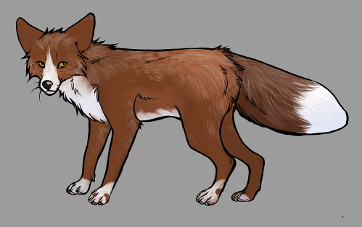
White mark applied to the burgundy fox.
Pink White Mark Fox !!
(Pink champagne white mark) Pink fox + white mark
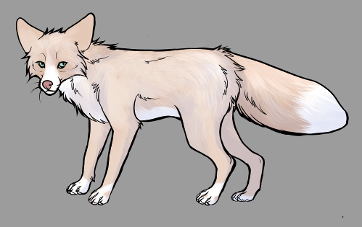
Whitemark applied to pink fox. Like the pink fox, will have blue eyes and a pink nose.
PLATINUM MUTATIONS of the SILVER FOX (Wpw)
This colouration first appeared in the 1930's in Scandinavia, but the same colour appeared in separate lines in the US and Canada over the course of the next decade from when it first appeared in Norway. Similarly to how the pearl fox received several different names, the platinum fox has been known as Mons platinum, Paulsrod fox, and Odnes fox. However, most of these names are now irrelevent outside of historical context, and platinum foxes are generally referred to as such. Platinum is also an encompassing market name for whitemark foxes as well.
Platinum foxes are characterized by dilution of all of the background colour of the fox, resulting in a pale coat, as well as generally large swatches of white on the face, legs, throat and underbelly. This is often distinguishable from typical whitemark foxes ,which have smaller areas of white and does not dilute the underlying colour. Platinum foxes, like white mark, can have heterochromia of the eyes or entirely blue eyes. Platinum is also an incompletely dominant gene that is lethal in homozygous condition. Thus, platinum foxes should not be bred to one another. This results in reduced litter sizes due to embryonic death.
Fox kits that are sometimes born are all white with blue eyes. These kits are very weak and usually die immediately after birth and generally do not survive into adulthood. The same can be expected if platinum is bred to whitemark or Georgian white. If one wishes to produce a platinum fox, it is best to mate a platinum parent with a silver or other non-lethal colour. Platinum foxes carrying the pearl factor tend to have a paler coat colour, similar to silver foxes carrying the pearl factor. The Platinum colouration can range from very pale to dark, and indiscernible from whitemark.
Platinum Fox !!
(Silver platinum) Silver + platinum - Wpw
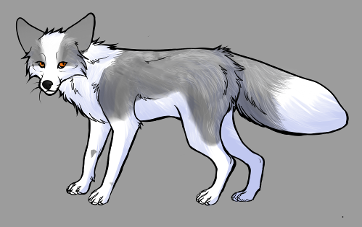
Any type of silver fox or mutation based on a silver background can have the platinum gene applied, such as fawn glow, amber, etc. A few examples are listed below.
Platinum Gold Fox !!
(Platinum red) Red/gold + platinum - AA BB/ Bb Wpw
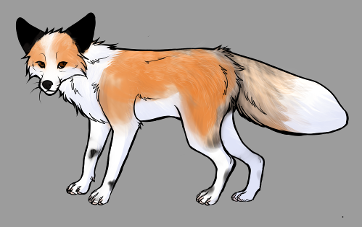
Platinum gold foxes are the result of the platinum gene applied to the gold fox. As a result, the red of the body is often diluted to a creamy orange colour, and the black of the body diluted to a gray.
Platinum red foxes tend to be more clear in colour, whereas platinum gold foxes can often be determined by the smoky colouration on their tail and body, indicating the heterozygous b gene.
In order to produce a gold platinum, the platinum parent must be a standard silver fox - AA bb Wpw with the platinum gene, or a gold platinum itself. Any type of gold fox background mutants such as amber gold, burgundy gold, etc. can have the platinum gene applied to it.
Platinum Cross !!
(Calico) Silver/gold cross + platinum - Aa Bb Wpw / Aa BB Wpw
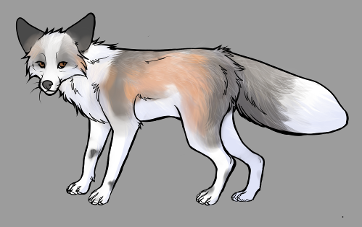
The platinum cross fox is also called calico, which is a shared name with the cross whitemark.
The platinum cross is the result of a silver or gold cross with the platinum gene applied. It can be difficult to determine if a platinum cross is truly a platinum cross, as certain individuals can be mistaken for a gold platinum.
Any type of cross fox can also have the colour platinum applied to it; burgundy cross, pearl cross, amber cross, etc.
Burgundy Platinum Fox !!
Burgundy + platinum - gg Wpw
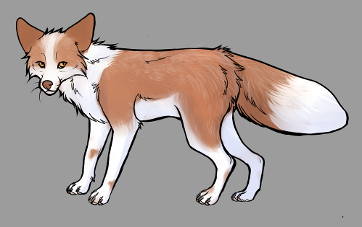
One of the examples of a recessive silver-based mutant with the platinum gene applied. This example is of the burgundy platinum. As a result of the dilution, the burgundy colour is diluted to a cream orange colour.
As burgundy is a market name for other brown mutants such as pastel, it can be assumed that burgundy platinum can also encompass pastel platinum foxes as well.
Pearl Platinum Fox !!
(Glacier, Glacier blue) Pearl + platinum - pp Wpw or ss Wpw
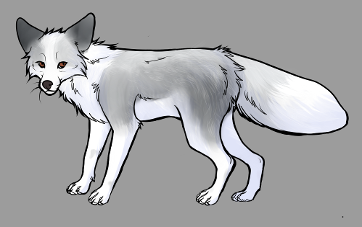
The pearl platinum fox shares the name glacier and glacier blue with the pearl white mark.
Very pale pearl platinum foxes can be almost white, and the colour is often difficult to tell apart from a standard silver platinum, as the diluted silver is difficult to distinguish from diluted pearl.
Platinum coat colour in red fox (Vulpes vulpes) is caused by a mutation in an autosomal copy of KIT
"The red fox (Vulpes vulpes) demonstrates a variety of coat colors including platinum, a common phenotype maintained in farm-bred fox populations. Foxes heterozygous for the platinum allele have a light silver coat and extensive white spotting, whereas homozygosity is embryonic lethal.
Two KIT transcripts were identified in skin cDNA from platinum foxes. The long transcript was identical to the KIT transcript of silver foxes, whereas the short transcript, which lacks exon 17, was specific to platinum. The KIT gene has several copies in the fox genome: an autosomal copy on chromosome 2 and additional copies on the B chromosomes... All genotyped farm-bred platinum foxes from Russia and the US were heterozygous for the SNP (A/G), whereas foxes with different coat colors were homozygous for the G allele. Identification of the platinum mutation suggests that other fox white-spotting phenotypes, which are allelic to platinum, would also be caused by mutations in the KIT gene."
MARBLE MUTATIONS of the RED FOX
The marble colouration originated in 1945 from a Norwegian farm, and was originally assigned the gene symbol M. However, it was discovered that it belonged to the allelomorphic white series and was changed to WM. This colour is often called the arctic marble, but this name has caused a great deal of confusion, especially in the pet industry, where the colour is mistaken for an arctic fox (vulpes allopex) or a red and arctic fox hybrid. The two are completely unrelated, and to avoid confusion the colour will be referred to in this guide as marble. The marble colouration applied to any background will result in a mostly white body, with colour being restricted to the ears, head, and sometimes a dorsal stripe or saddle, as well as markings on the tail and spots on the legs - all depending on the paleness of the marble.
Silver Marble Fox
(Arctic marble, marble) Silver + marble - WMw
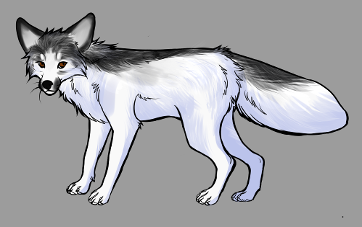
Also can be simply referred to as marble. Silver plus the marble gene, can vary from dark to pale.
Red Marble Fox
(Sun glow/glo, Gold marble) Red/gold + marble - AA BB WMw / AA Bb WMw
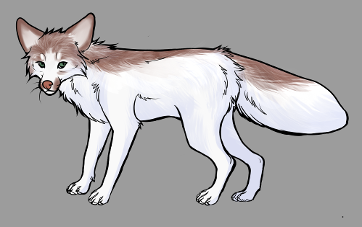
Commonly called sun glow, the gold/red marble is the result of the heterozygous marble gene applied to the gold fox. Gold cross foxes are also occasionally referred to as sunglow foxes as well, and can be difficult to differentiate from a true gold marble.zygous marble gene.
Amber marble may also account for fawn glow marbles, etc.
Cross Marble Fox
Silver/gold cross + marble - Aa Bb WMw / Aa BB WMw
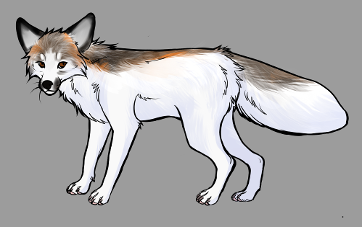
Silver or gold cross fox with the heterozygous marble gene.
Other cross types may also have the marble gene applied (pearl, burgundy, etc.)
Burgundy Marble Fox
Burgundy + marble - gg WMw
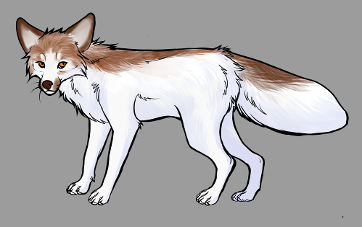
Burgundy and heterozygous marble gene.
Amber Marble Fox
Pearl + burgundy + marble - gg pp WMw

Amber marble is the result of the amber colouration, created by combining pearl and burgundy, with the heterozygous marble gene.
Amber marble may also account for fawn glow marbles, etc.
Pearl Marble Fox
Pearl + marble - pp/ss WMw
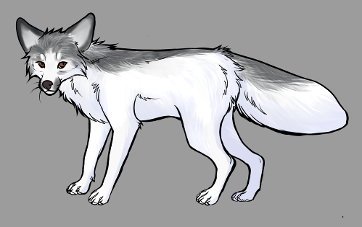
Pearl marble is the result of either pearl colouration with marble applied.
Pearl marble can be somewhat difficult to tell from standard silver marbles, especially in photographs, but they generally have the notable gray-blueish colouration of pearl foxes in the areas where colour is present.
Pink Marble Fox
(Pink champagne marble, champagne marble) Pink + marble - WMw + ??
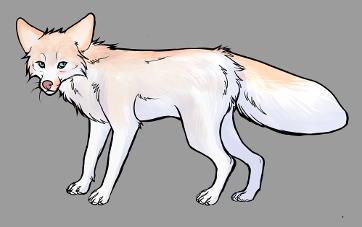
Marble applied to the pink fox. Like the pink fox, these foxes will have pink noses and blue eyes, and can appear to be almost white because of how washed out the pink is.
They're also sometimes sold as extra pale pink foxes in the fur market.
White Marble Fox
(White fox, arctic marble white, atom fox) Marble + Marble - WMWM
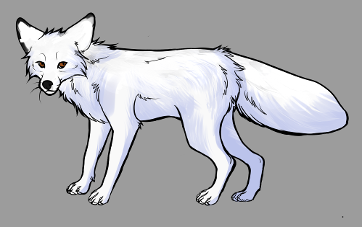
White marble typically refers to homozygous marble on a silver fox background, but homozygous marble is a dominant mutation that can occur over any background and colouration.
As marble is not lethal in homozygous condition nor is it incompatible with the other white series mutations, it is possible for any colour to present with the white marble. However, regardless of the colouration, the fox will appear visibly the same.
The only notable difference in colouration is of the very small area of colour on their ears, as well as their nose and eye colours. For example, a white pink marble fox may have blue eyes and a pink nose, but but be otherwise white. Whereas, most white marbles will have dark eyes and dark noses.
Other possible genetic backgrounds of white marble foxes include:
- Aa BB WMWM - White marble gold cross
- AA BB WMWM - White marble sun glow
- Aa Bb WMWM - White marble silver cross
- gg pp WMWM - Amber marble white -
- pp WMWM - Pearl marble white
- gg WMWM - Burgundy marble white
When this colouration was first documented in 1959, it was also referred to as the 'atom fox'.
Silver Marble Platinum Fox !!
Marble + Platinum - WMWP
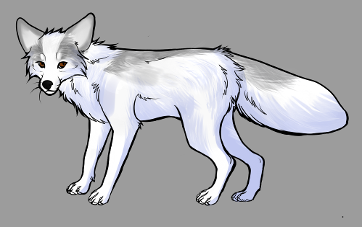
Marble can be combined with the platinum gene to create washed-out marble foxes, diluted by the presence of the platinum gene.
This is a result of breeding a marble fox to a platinum fox, as this combination of white mutants is safe; however, since the platinum gene is present in marble platinum offspring, they are incompatible with white series colouration other than marble.
Similarly to white marble, any colouration that can occur as a platinum colouration can be combined with marble to create a marble platinum fox. Some examples of genetic names and breakdowns are below.
- Arctic marble platinum - WMWP
- Sun glow platinum - AA BB WMWP
- Sun glow platinum gold - AA Bb WMWP
- Marble platinum gold cross - Aa BB WMWP
- Marble platinum silver cross - AaBb WMWP
It is difficult to distinguish a marble platinum from a simple marble fox, thus it is important to know the heritage of a marble fox before breeding it to another white series colouration.
GEORGIAN MUTATIONS of the SILVER FOX (WGw)
The Georgian white, also called the snow mutant, was first documented in Russia in 1943. It is a white fox with black spots on the face, back and feet, but it's markings are distinct in their organization from marble foxes. These foxes are often described as 'freckled'.
The gene is incompletely dominant, and is lethal in homozygous condition. Therefore, Georgian foxes should not be bred to one another, nor any other white series colouration besides marbles. These foxes were heavily restricted when they were first discovered during the period of the USSR, and for a time only existed in Russia. They now are present across Europe, but they are not in the North American pet trade at this time, except for Russian domesticated foxes imported to the US. Georgian white can hypothetically exist with any other colouration (amber, burgundy, pearl, etc.), but only two variations are currently well documented, with another; the Georgian Brown fox, being known.
It is also thought that the connection to genes and light colouration, as seen in English spotted rabbits and Georgian White foxes, causes "Incomplete dominance, low viability of homozygotes during early postnatal period [and] abnormal peristaltic potentially leading to megacolon often during transition to solid food"
Georgian fox genetics (along with the Pastel fox) were once considered a protected agricultural resource in Poland, in order to prevent loss of diversity and extinction. Part of a larger World Strategy for the Conservation of Genetic Resources of Farm Animals, developed by the United Nations Food and Agriculture Organization (FAO).
Georgian White Fox
(Snow mutant, snow fox) WGw
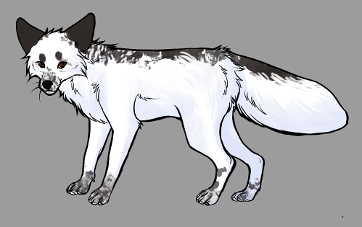
The typical Georgian white exists on a silver fox background, with most of the body being white, and patches of black along the back, on the muzzle, face, ears, and legs of the fox.
It is distinctive from marble foxes in that their ears usually often solid black.
Georgian Red Fox
(Red Georgian) Georgian white + red -AA BB/Bb WGw
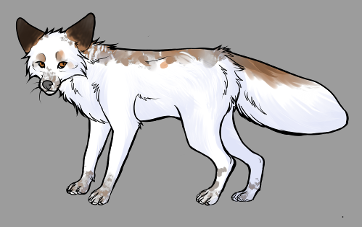
Red Georgian whites are the result of a red background on a Georgian white fox.
"The farm breeding of foxes began in Easter Canada in the late 19th Century. Through fox farm breeding, several new colour variants have been identified, with the Georgian White (GW) morph first being described... in Georgia in 1943. Georgian white foxes are... characterised by white coat color, brown eyes, a black nose and black spots on the head, along the spine and on some other parts of the body...
Blood samples were collected from 13 three-generation pedigrees produced by breeding GW and standard silver foxes... at the Institute of Cytology and Genetics... Russia. DNA was extracted... the pedigrees were genotyped... Linkage mapping... identified the most significant linkage between GW markers on fox chromosome 2... Recently, we have shown that a mutation in the KIT gene causes platinum coat color in foxes. Allelic interaction among the GW and platinum coat colors has previously been established through cross breeding of GW and platinum foxes. The mapping of the GW allele.. is thus consistent with the results of the experimental breedings and suggests that GW is also caused by a mutation on the KIT gene"
EXTINCT MUTATIONS of the SILVER FOX
As a result of World War II in the 1940's, fur farming experienced a significant decline, and as a result, a couple of different colour variations went extinct.
Radium Fox (rr)
(Irradium, Eberland white)
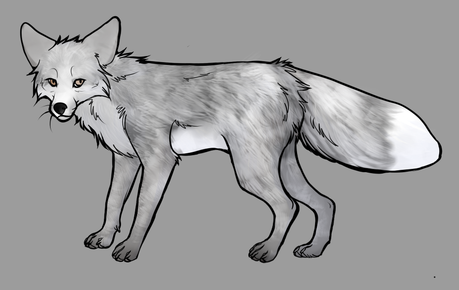
Radium foxes are described in the literature as being having normal guard hairs with a silver bar, it also had completely white guard hairs evenly distributed over the body, and underfur lighter than that of a silver fox.
IT was considered a beautiful fox, but was lost during the decline of fur farming.
Opal Fox
Opal foxes were born out mating with a separate whiteface type called Huitfeldt foxes (also extinct, but identical in appearance to whiteface).
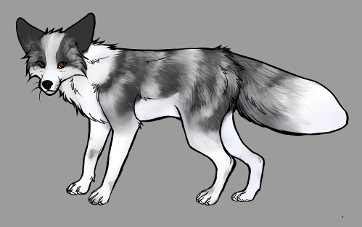
These foxes, in addition to large white markings on the body, had large, transverse stripes all over the body that resembled brindle in other mammals.
Paying for breeding services in 1940 with an Opal fox was 2000 to 4000 Norwegian krones, which in today's terms, was $6,300 to $12,800.
The Genetic Factors for Colour Types in Ranch Bred Foxes;
"The colour type called radium fox is described as a dark colour phase with sprinkling white hairs all over the body, also on the feet, belly, nose, ears and tale. The coat colour, especially the underfur, is generally lighter than on silver fox (Johansson, 1949). The letter r is suggested for the symbol of the mutant gene responsible for this coat colour...
"Hiiitfeldt fox and Opal fox. The Huitfeldt fox or Meldal fox was a white face-like mutation in silver fox, which was-born in Meldalen in Norway, most likely in 1938. It was described as a silver fox type with great white markings like those of the platinum fox. Mating with 18 silver fox females resulted in cubs in proportion of about half and half of each colour type. This indicates the same mode of inheritance as for the former white face mutations (Anonymous, 1939~). according to Nordang (1941), however, the Huitfeldt fox also produced brindled offspring when mated with silver fox and platinum.This colour type was named Opal fox..
A new type appearing among a fur animal population does not always have to be a mutant. It may be a combination of some earlier known types. Even modifying genes in combination with mutation factors can produce new colour shades. They may also be caused by gene interaction or environmental factors, e.g. the Platinum Blue fox (Slagsvold, 1949). If so they may appear suddenly as mutations do, but are not reproducible. It is important to distinguish between genetical mutations and irreproducible phenotypes. On the other hand it is not reasonable to regard mutants caused by genes at the same locus as different types, if they cannot be differentiated in practical breeding. They must be looked upon as replicates of earlier mutations and not as new ones. A phenotypically new type can only be accepted as a new mutation with a name of its own when its inheritance has been investigated under appropriate scientific control. Furthermore, one of the following qualifications must be fulfilled."
COLOUR-CHANGING FOXES
There are several different circumstances that may occur where a fox's coat colour may change. This can be down to a variety of different reasons including stress, illness or even environmental factors. Known conditions that can result in a change of coat colour in foxes are listed below.
Fever Coat in Foxes

Extreme stress or infection in a pregnant vixen can result in fever, which in turn can disrupt the distribution of temperature-sensitive pigment cells during neural crest development of the young.
It can effect the whole litter to varying degrees and makes the young appear paler or even white at first, but as they age they will begin to darken and by the time they reach their first full molt at aged two, they will generally have developed their full colouration.
Leukotrichia & Vitiligo

Leukotrichia and vitiligo are conditions that produce a white spotted effect within the coat of animals of many species. Animals of any age can be effected and it may progress in time, with the animal turning completely white or developing increasing patches of discolouration as it ages.
"Leukotrichia" is the technical term for what is generally considered to be an acquired de-pigmentation that occurs over an animals lifetime. It is usually progressive in nature, being triggered by illness, stress or environmental factors.
"Vitiligo" is a considered a heritable condition of the immune system that is then triggered by environmental factors. The conditions cause antibodies to be formed against pigment-producing melanocytes. It is the destruction of these melanocytes that leads to the observed de-pigmentation.
Nasal Depigmentation - Dudley Nose or Snow Nose
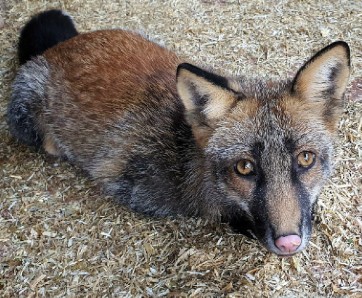
Nasal depigmentation is a condition in which there is little known. It is a superficial skin complaint that doesn't cause health issues and is often recorded in dogs.
Most often, there is no known cause and the condition is generally considered idiopathic, but autoimmune conditions such as lupus, parasitic infections such as leishmaniasis and genetic conditions such as vitiligo can sometimes be behind it.
The condition can be temporary or permanent but usually causes no serious health issues. In dogs, the condition is often associated with animals that carry the recessive red gene and those with the liver colouration.
FOX TAIL VARIATION
The tail of the red fox is known worldwide for its russet colour and its distinctive white tail tip, but there is a wide range of polymorphism to fox tails or 'brushes', as they are also known. Another less commonly reported feature of red fox tails is the ventral line of black hair often found on the underside of the tail. Fox tails can also display full or partial melanism and foxes with this trait are termed a 'black brush' foxes.
A white tail tip is commonly present in all colour variations of red fox and its genetic expression is independent of coat colour, however, full or partial tail tip melanism does occur. Tail tips can also present with a yellow hue and in some cases, tail tip differentiation can be completely absent.
Foxes use their brush as communication tool, as a windbreaker when sleeping and they also act as a rudder to direct their spectacular pounces. Foxes in Canada and North America have an exaggerated tail tip in comparison to their European relatives and commonly have thicker fuller brushes, which allows them to survive in the harsh cold climate of the sub arctic tundra. Little is know scientifically about the mechanisms and significance behind these adaptive traits.
The following excerpt is from Roger Burrows book Wild Fox: A Complete Study Of The Red Fox:
"My own observations on both living and dead foxes indicate that each fox differs, usually slightly, in some aspect of its coloration. Some are reddish brown, others decidedly ginger, whilst grey foxes are fairly commonly seen. Some foxes have white chests and underparts, others have these areas sooty or nearly black.
The tip of the tail, or tag, shows wide colour variation and may be black, white or, as in the case on one of Kent's Green vixens, decidedly yellow/buff. A white tail tag does not indicate a dog fox, as used to be thought, and we know that only a proportion of foxes have the white or albino tip, which is not, therefore, a characteristic of the species as authors suggest.
From the little information we have on this subject (Corbet, 1963), roughly 73 percent of fifteen foxes examined from England and Wales and just over 87 percent of thirty-one Scottish foxes had the white tag. The conclusion must be that the majority of British foxes do have the white tail tip but that this feature is not the monopoly of the male"
